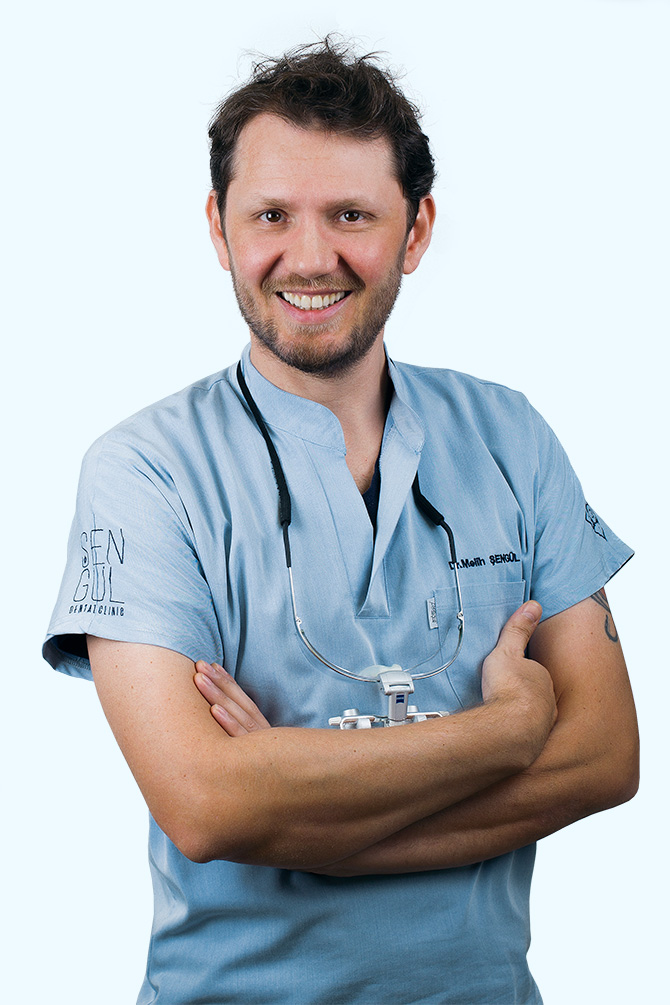The chewing system primarily includes the teeth, chewing muscles, and temporomandibular joints (TMJ). Our body has highly sensitive, complex, and extensively interconnected biomechanical functional units. If the biomechanics of the chewing system are somehow disrupted, this can lead to temporomandibular disorders (TMD) or similar conditions. The harmonious interaction between the upper and lower jaws, provided by the TMJ and chewing muscles, is essential for our health. If this harmony is disturbed, chewing, swallowing, and using facial muscles can become painful and difficult. The TMJ, when not in its proper anatomical position and negatively impacting surrounding tissues, can also adversely affect overall body health and posture.
The resulting symptoms are complex and difficult to explain. Therefore, patients affected by this condition are often told that these complaints are psychological or stress-related, and treatments are administered accordingly. Additionally, some cases are diagnosed as “bruxism” or “teeth grinding.” This diagnosis is also not helpful in the treatment process because, in our view, teeth grinding is not the disorder itself but a result of underlying complex problems. Biomechanical imbalances in the chewing system are often the real cause of these complaints. Patients with TMD are generally given exercises, antidepressant medication, muscle injections, and night guards. These options reduce the patient’s complaints but never provide a definitive solution to the underlying problem.
Detecting such disorders within the chewing system, recognizing their causes, and treating them often requires collaboration with other fields. The goal is for patients to live without symptoms and complaints, without needi
In our treatments, we passionately and meticulously apply our experiences to achieve lasting results, particularly by addressing the functional aspects of your chewing system. We focus on the biologically correct treatment of your chewing system affected by functional disorders.
The fundamental principle of our approach is the biofunctional holistic treatment concept.
This concept is based on accurately measuring and observing the factors in your chewing system: the stable orthopedic position of the TMJ, well-defined occlusion (the closure of the teeth), and natural tooth forms. These elements are responsible for the long-term functional health of the chewing system. Physiological function, comfortable chewing, longevity, and aesthetic appearance depend on the ideal biological shapes of these tissues.
Common Symptoms:
- Head and facial pain
- Tension in the head, neck, and shoulder muscles
- Migraine-like pain and complaints
- Pain in the TMJ
- Various damages in the TMJ (clicking and grinding sounds, reduced freedom of movement)
- Pain spreading to the teeth, mouth, neck, and shoulders
- Difficulty swallowing
- Heaviness in the lower jaw
- Ear pain
- Feeling of fullness in the ears
- Tinnitus
- Waking up tired in the mornings
- Eye pain, increased sensitivity to light
- Neuralgia
- Dizziness, vertigo
- Sleep disorders
- Depressive mood
Teeth, chewing muscles, and TMJ are interconnected in a highly sensitive, complex, and biofunctional manner.
The chewing system remains stable and continues to work healthily for a long time only if the following conditions are met:
- The TMJs return to the “zero point” (centric relation of the TMJ) at the end of each chewing cycle.
- Meanwhile, all teeth in the lower and upper jaw come together simultaneously without affecting the centric position of the TMJ.
- The spatial relationships between the teeth in the lower and upper jaws adhere to biological principles, and the teeth are not worn down and remain in their normal form.
If those conditions are not met, each anatomical structure and tissue is inevitably subjected to unnatural stresses. Such functional disorders can also result from inadequate dental restorations or poorly performed orthodontic treatment. Patients affected by this condition do not notice their discomfort for a long time; the chewing system temporarily “adapts” to this situation. This adaptation causes continuous wear on the teeth over the years, unrelated to the side effects of aging and natural processes. Most patients are usually labeled as “teeth grinders” or “bruxism patients,” with the condition thought to be psychological or stress-related. None of these approaches can fully resolve the problems.
Additionally, the patient may feel that their bite is incorrect but not show other symptoms initially. When the body can no longer compensate for these irregularities, various diseases and symptoms can develop.
Since the chewing system is not an isolated organ, these disorders can affect the entire body. These disorders are grouped under the collective term “temporomandibular disorders.”
Biofunctional Reconstruction of the Chewing System is Divided into Three Main Treatment Stages:
Stage 1: Preliminary Treatment of TMJ and Chewing Muscles
One of the most important characteristics of a healthy chewing system is the correct positioning of the TMJ. Therefore, in the first stage of our treatment, we ensure the TMJs are in their natural and healthy orthopedic position. To achieve this, we use a splint called MAGO, which eliminates biomechanical irregularities in the teeth. The MAGO splint is different from a simple night guard to prevent teeth grinding. No intervention on the teeth is necessary during this stage of treatment.
Thanks to its highly sensitive and purpose-driven design, the MAGO splint stimulates correct biomechanical chewing movement, allowing the chewing muscles, TMJ, and teeth to work together in perfect harmony. The duration of splint use varies depending on the severity of dysfunctional conditions. Adjustments can be made to the MAGO splint during the healing process of the structures and tissues of the chewing system, making both its use and treatment easier. At the end of MAGO treatment, the structures of the temporomandibular joint heal physiologically in the correct orthopedic position, stabilizing reliably. Thus, the correct centric position is determined reliably and can be repeated with each chewing motion. This stabilization is essential for the functional correctness and longevity of future reconstructions.
Since the chewing system is not isolated in the body, we also evaluate and consider the body posture before our treatment. Occasionally, we can benefit from physiotherapy support parallel to MAGO treatment. In such cases, MAGO treatment ensures that the success of physiotherapy is lasting.
At this point, we have two options:
- Functional diagnosis and treatment: the functional adaptation of the teeth and biomechanical restoration of the chewing system are performed, eliminating the need for an occlusal splint. THE BEST SPLINT IS THE TEETH THEMSELVES!
- If no intervention on the teeth is desired, the patient can continue using the MAGO splint to remain asymptomatic.
If the patient chooses the first option, the next stage of treatment is as follows:
Stage 2: Diagnosis and Treatment Plan
Based on the TMJ position and measurements determined at the end of the first stage, the necessary changes to create a harmonious functional chewing system are identified.
In this stage, we work with jaw models for each tooth’s future state, ensuring the entire system functions perfectly. Changes needed for the teeth may be a small shape correction or a major restoration. In some cases, initiating orthodontic treatment can be a good way to avoid major restorations on the teeth.
Creating the final restorations’ wax-up requires knowledge of the chewing system’s biomechanics. We use this knowledge to prepare the wax model, showing the patient the finished state and explaining all treatment stages.
Stage 3: Transferring the Wax Model to the Mouth (Mock-Up)
Adapting the wax model to the mouth for a successful outcome requires good planning and precision. For example, the determined TMJ position from the first stage must not be disrupted, and each tooth must touch specific points on the opposing teeth. These fine details are crucial for long-term success.
For these reasons, in most cases, at least some teeth are initially adapted with temporary restorations. These temporaries are made with the same form and precision as the final permanent restorations.
Additionally, these restorations have the advantage of being adjustable in the mouth for the health of the periodontium, muscle system, and TMJ. Necessary adjustments, refinements, and fine-tunings are made on these temporaries before proceeding with the permanent ceramic restorations, eliminating the need for splints.
For those with some degree of TMJ problems, intervening in dental treatments solely for aesthetic reasons can be incorrect and worsen the condition.
While aesthetics is not the primary goal of our jaw orthopedics treatment concept, a healthy and functional chewing system automatically provides a good aesthetic appearance. This perspective significantly differentiates the biofunctional treatment concept from purely cosmetic dental procedures.
Biofunctional dentistry aims to create a long-lasting and naturally beautiful chewing system in the best way possible.
In addition to providing high-quality general dental care to our patients, we guarantee technical precision, ideal aesthetics, and longevity in the comprehensive and functional rehabilitation of the chewing system.
Based on experimental findings and the underlying scientific research, we see that the chewing system is in balance with the rest of the body as a very sensitive and biofunctional organ, separate from other organs. Our approach is not merely symptom-focused dental treatment. We care for our patients by finding the causes of their symptoms and providing long-term treatments, especially for those with TMJ disorders.
The fundamental principle of our approach is based on the biofunctional treatment concept developed over many years in the United States. The long-term professional network we have established with recognized experts in various fields of dentistry gives us access to treatments that meet the highest standards of dentistry. With our experience, precision, and passion, we dedicate ourselves to your treatments.
We provide treatments at the highest standards and continue to develop ourselves. Our patients come from various provinces in Turkey and other countries, including many colleagues and dentists.
Temporomandibular Disorders:
Temporomandibular disorders (TMD) is a collective term for a group of symptoms that present themselves either alone or in combination:
Common Symptoms:
- Head and facial pain
- Tension in the head, neck, and shoulder muscles
- Migraine-like pain and complaints
- Pain in the TMJ
- Various damages in the TMJ (clicking and grinding sounds, reduced freedom of movement)
- Pain spreading to the teeth, mouth, neck, and shoulders
- Difficulty swallowing
- Tinnitus
- Eye pain, increased sensitivity to light
- Neuralgia
- Dizziness
- Sleep disorders
- Depressive mood
Have any question?
Make an appointment
Ask your questions to Prosthodontist Dr. Melih Şengül about Zirconium Crowns and general dental treatments via the form below:

with Dr. Melih Şengül
Make an appointment
You can make an appointment by calling 0 (531) 640 33 73 or clicking the button below.
Other Treatments
/melihsengul


